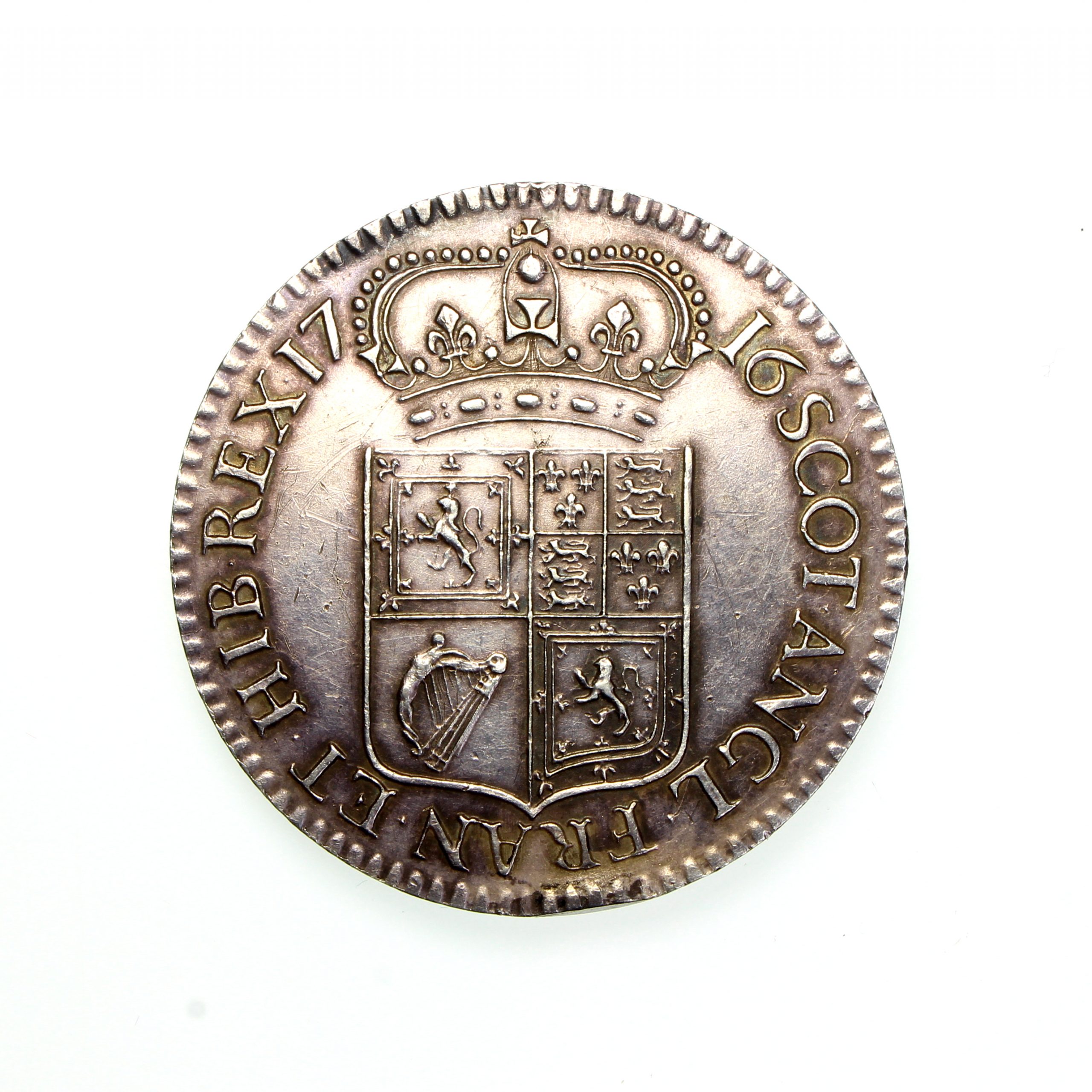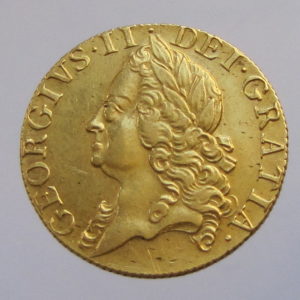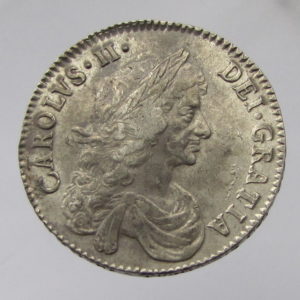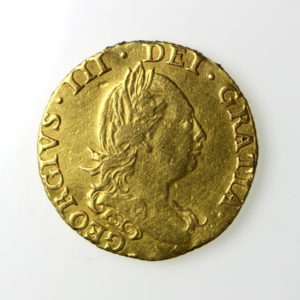Scotland James VIII ‘The Old Pretender’ Silver Pattern Crown 1716AD extremely rare
£2,950.00
Scotland James VIII ‘The Old Pretender’ Silver Pattern Crown dated 1716AD – extremely rare
38mm, 31.35g, S5731
small edge bruise at 6 0’clock on reverse.
Scotland, James VIII (b.1688-d.1766), Pattern Restrike Crown of Sixty Shillings, dated 1716, struck in silver c.1828 by coin dealer Matthew Young, from recommissioned original dies engraved by Norbet Roettier, laureate and draped bust right, legend and toothed border surrounding, IACOBVS. VIII. .DEI. GRATIA., rev. inverted die axis, crowned quartered shield of arms, date either side of crown, legend and toothed border surrounding, SCOT. ANGL. FRAN. ET. HIB. REX, edge plain, 28.71g (Burns 1, fig.1094; Woolf 33:1; Bruce XPT 2; S.5731). This example shows very few rust spots (below bust) which are normally seen on these coins. These being a result of the repurposed dies striking this coin in c.1828, Burns states that only sixty were struck in silver.
James III / VIII and the Preparation for a Coinage:
James VIII of Scotland otherwise known as James Francis Edward Stuart, the “Old Pretender,” the son of James II of England / James VII of Scotland, was born on 10th June 1688 by James II’s second wife Mary of Modena and was brought up in France. His elder half-sister – some 26 years older – was Queen Mary II of England, acceding to the throne on 26th February 1688/9 with her husband William III, when the infant James VIII was just 8 months old. Later at the Treaty of Ryswick on 20th September 1697 the childless William III was due to consent to the succession of 9-year-old James as Prince of Wales, but later rejected this. On the death of William III on 8th March 1701/2, James Stuart’s Kinsman Louis XIV of France proclaimed him King having been present at the Treaty of Ryswick. However, this was not to be, as Mary II’s younger sister Anne succeeded William. It is believed that at first Queen Anne privately wanted James VIII to succeed her, though she could not utter such a desire officially in public. In late March 1708 at the age of 20 James VIII was involved in his first unsuccessful expedition from France to invade north east Scotland with 5,000-6,000 French soldiers in an attempt to restore him to the throne. On 3rd April 1708 it was Queen Anne that had given James Stuart the moniker “Pretender” when she informed Parliament of James’ embarkation, and declared “all those who joined the “Pretender” on whose head a price was set, were guilty of high treason.” However, the ships were unable to disembark their troops in Scotland and ended up returning home to Dunkirk.
After the death of Queen Anne on 1st August 1714 and the accession of the Hanoverian George I, the still single 27-year-old James Stuart organized another invasion force that landed at Scotland in 1715, and had it not been for the news of the death of Louis XIV on the 1st September 1715 he may well have succeeded. The Standard of James Stuart was raised by the Earl of Mar at Braemer on 6th September 1715 and he was proclaimed King in several Scottish towns. Having made his own Declaration of Kingship at the Court of Commercy in France on 25th October 1715, James VIII procured his own arrival at Peterhead, Scotland on 22nd December 1715. However, during November the Jacobites had suffered defeats at Sheriffmuir and Preston by the forces of the Duke of Argyll, and James soon caught a fever on arrival in the harsh Scottish Winter. Setting up his Court at the Palace of Scone he soon learnt of the advance of the Duke of Argyll’s forces and decided to retreat back to France sailing from Montrose on 5th February 1716 demoralised. James ended up retreating to exile in Papal territory as he had now become too much of an embarrassment to the French to reside there.
It was in this backdrop that James Stuart in preparation for his taking of Scotland instructed Norbert Roettier to prepare dies for coinage dated 1716 as can be seen from the Calendar of Stuart Papers (volume I, page 503) which would be ready for dispatch to Scotland once James had arrived there. He was already very familiar with the work of the Roettier family, who had been responsible for his Father’s and Uncle’s regal coinages with his Father retaining their services after his enforced abdication. Joseph Roettier as Graveur-General to the French Mint was succeeded by his Nephew Norbert, as James Roettier had died in 1698 and John Roettier in 1703.
The warrants previously under James II were renewed under the 15 year old “James III” in June 1703 for Norbert Roettier as Engraver-General to the English Court at St. Germains (where his Father James II of England has passed away on 16th September 1701). Norbert had worked directly with the portraiture of James Stuart until as late as 1712 for medallic commissions, and was the Engraver of James III’s rare “touch pieces” in the names of “James 3” used as healing amulets for the Kings Evil, that James will have distributed to Jacobite sufferers of scrofula and other such ailments. Norbert had also been presented warrants on 31st October 1701 for the making and engraving of the Great Seal for the Kingdom of England, and later on 15th October 1702 for seals of Scotland and Ireland.
There was a warrant issued at the English Court of St. Germains for coinage to Norbert Roettier on 4th May 1708 to prepare “puncheons and dyes for coining five-pound pieces, forty-shilling pieces, guineas and half guineas of gold with our Royal Arms on one side, and the picture of Our Royal Self on the other” no doubt for the first aborted attempt to invade England and Scotland. This warrant is interesting in perhaps it is the first use of the word “Guinea” for the denomination, pre-dating Sir Isaac Newton’s official Royal Mint paper of 1717 that first named the “Guinea” in England by some 9 years, though of course it was an instruction to someone who was involved with the French Mint rather than the English.
The result was the unique pattern Crown dated 1709 struck in silver since housed in the British Museum (ex Wigan Collection 1872 and ex General Yorke Moore who obtained it abroad when first exhibited anonymously at a Numismatic Society meeting in 1851), which would have been struck in quantity for circulation if the first invasion succeeded in 1708, and the crown die was the only coin die completed. Norbert Roettier had also advanced as far as making the puncheons perhaps for use with the various denomination from Five Guineas, Guinea, Halfcrown and Shilling, as these tools and dies still survive in the British Museum and are illustrated by Helen Farquhar in her article in the British Numismatic Journal 1906, pages 229-270 – “Patterns and Medals bearing the legend Jacobus III or Jacobus VIII.”
It was from these medallic portraits that Norbert Roettier still holding the coinage warrant, depicted a youthful James on the pattern coins dated 1716, as he had had no opportunity for a live portrait sitting with James since as late as 1712, (after which James favoured the Italian engraver Ottone Hamerani for his touch-pieces and medallets); and it was perhaps easier to adapt portraits from previous medallets as per the James Tertius pattern Guineas, or from the 1709 dated pattern Crown. The 1716 Guinea portrait with James VIII legend as depicted on the piece offered here, very closely resembles the 1709 Shilling puncheon tool.
As can be seen from the mute result of James’ expeditions to Scotland there was no demand to strike any coinage at all in the end, and the unused dies dated 1716 languished in the possession of the family of Norbert Roettier for decades. They were no doubt never paid for at the court of the “Old Pretender” as the widow of Norbert, he having died on 18th May 1727, was writing to James Stuart in that year for “compensation” for the work on the dies that she as his second wife clearly still possessed.
James Stuart was married in 1719 to Maria Clementina Sobieska and had two sons, the eldest of which became “Bonnie Prince Charlie” styled as the “Young Pretender” who was defeated at the Battle of Culloden in April 1746.
James Stuart lived to see this crushing defeat and died on New Years Day 1766 and was given a funeral fit for a King and had he reigned his tenure would have been six months longer than Queen Victoria!
The Striking of the Coins 1828:
In the year 1828 the surviving dies and tools by Norbert Roettier found their way to the London coin and medal dealer Matthew Young (1771-1838) operating from various addresses in London, but latterly at 41 Tavistock Street, Covent Garden (1827-37). Young was London’s premier dealer of his day, and probably the most prominent coin dealer in England at the time. He was a personal friend of many of the top collector’s and medallists of his day, he published Numismatic books and series of medallions as well as cataloguing collections known to him, when sold at Sotheby.
It seems in 1828 Mr Young bought a whole parcel of Jacobite dies from a Mr Cox who had previously obtained them from the Roettier daughters in a state of advanced age, presumably in the 18th Century. Matthew Young recommissioned dies into use by concentrically polishing the rust from the surfaces; and struck a limited number of specimens of coins that effectively could have been in varying metals for collectors. He is known to have struck 1716 dated “James VIII” Sixty Shilling Crowns in both gold (3 perhaps struck), silver (60 struck) and white metal; as well as the pattern Guinea in gold (a handful struck), silver (unknown number) and copper (very few). There is a further “James Tertius” pattern using a medallet obverse coupled with the Guinea reverse struck in silver and copper (G.F. Crowther in his book on English Patterns published in 1887 states only twenty were struck in silver of the James Tertius piece, but did not list the James VIII Guinea we have here). Matthew Young additionally recommissioned unused dies for a Sixty Shilling piece dated 1688 of James II of England of which a limited number were struck in gold and silver.
After Matthew Young had finished his production run, he defaced all the dies and presented them to the British Museum, where Helen Farquhar examined them in 1906 for her article cited earlier. Miss Farquhar reports interestingly that there were several reverse dies of the 1716 pattern Guinea, only two of which were restored for use by Young, one with thistle at centre for the James VIII piece, and one probably an earlier die proposal by Norbert Roettier without the central thistle that was coupled with the medallic James III obverse.
Out of stock












